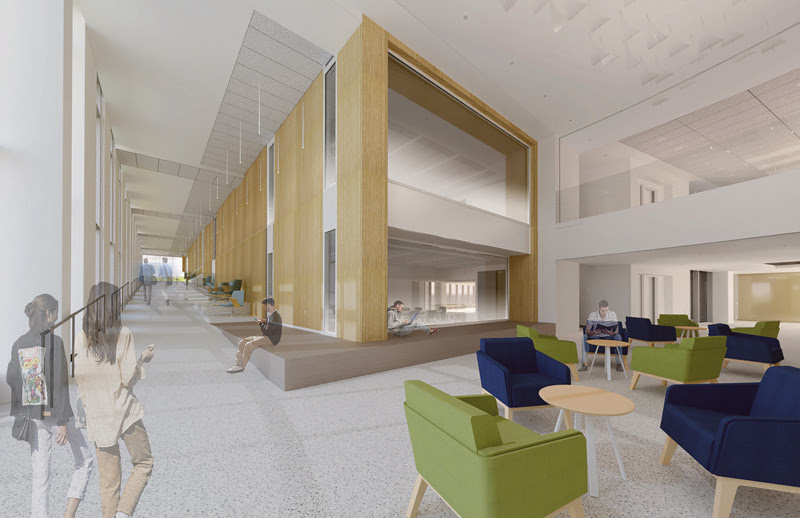The University of Maryland has a new landmark architectural presence in its new School of Public Policy building.
The building’s design concept is rooted in the spatial typology of the ancient Agora, the birthplace of democratic thought and public discourse. The cascading architectural form follows the natural slope of Chapel Field to form an edge to one of the signature open spaces on campus and shape a carefully orchestrated sequence of interior spaces.

Entrances on the east and west sides connect to a large, communal atrium designed to encourage chance meetings, informal study, and interdepartmental collaboration. On the building’s east side is Do Good Plaza, a shared outdoor event space that establishes a new gateway into campus. Brick cladding and white columns connect visually with Lee Hall to the north while the building’s sculpted massing frames Rossborough Inn to the northeast and memorial Chapel to the southwest.

The four-story building brings together the School’s more than 90 faculty members and over 1,000 undergraduate and graduate students and serves as the headquarters for the Do Good Institute, a campus-wide hub for social innovation, philanthropy, and nonprofit leadership. The facility will also include five instructional spaces ranging in size from 25 to 150 seats, a library, and a rooftop terrace.
See Also: South-West Middle School welcomes its first students
The School of Public Policy is expected to achieve LEED Gold rating with biophilic design elements that will connect occupants to nature, reduce the building’s environmental footprint, and provide healthy and productive spaces for work and study.
Related Stories
University Buildings | May 19, 2015
Renovate or build new: How to resolve the eternal question
With capital budgets strained, renovation may be an increasingly attractive money-saving option for many college and universities.
University Buildings | May 19, 2015
KU Jayhawks take a gander at a P3 development
The P3 concept is getting a tryout at the University of Kansas, where state funding for construction has fallen from 20% of project costs to about 11% over the last 10 years.
University Buildings | May 5, 2015
Where the university students are (or will be)
SmithGroupJJR's Alexa Bush discusses changing demographics and the search for out-of-state students at public universities.
BIM and Information Technology | Apr 9, 2015
How one team solved a tricky daylighting problem with BIM/VDC tools, iterative design
SRG Partnership's Scott Mooney describes how Grasshopper, Diva, Rhino, and 3D printing were utilized to optimize a daylighting scheme at Oregon State University's new academic building.
Sponsored | University Buildings | Apr 8, 2015
Student Housing: The fight against mold starts in the bathroom
University Buildings | Apr 8, 2015
The competitive advantage of urban higher-ed institutions
In the coming years, urban colleges and universities will outperform their non-urban peers, bolstered by the 77 million Millennials who prefer to live in dense, diverse, and socially rich environments, writes SmithGroupJJR's Michael Johnson.
University Buildings | Mar 18, 2015
Academic incubators: Garage innovation meets higher education
Gensler's Jill Goebel and Christine Durman discuss the role of design in academic incubators, and why many universities are building them to foster student growth.
Retail Centers | Mar 10, 2015
Retrofit projects give dying malls new purpose
Approximately one-third of the country’s 1,200 enclosed malls are dead or dying. The good news is that a sizable portion of that building stock is being repurposed.
University Buildings | Feb 23, 2015
Future-proofing educational institutions: 5 trends to consider
In response to rapidly changing conditions in K-12 and higher education, institutions and school districts should consider these five trends to ensure a productive, educated future.
University Buildings | Feb 20, 2015
Penn strengthens campus security by reviving its surrounding neighborhood
In 1996, the University of Pennsylvania’s sprawling campus in Philadelphia was in the grip of an unprecedented crime wave. But instead of walling themselves off from their surrounding neighborhoods, the school decided to support the community.
















